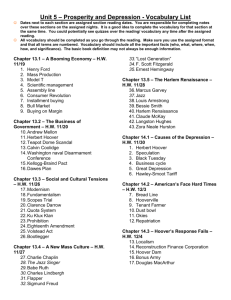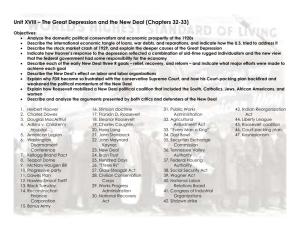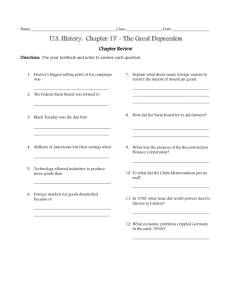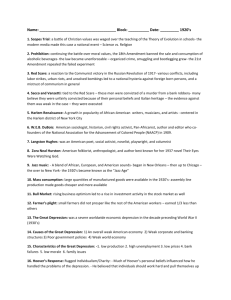Unit 7 revised 2009
advertisement
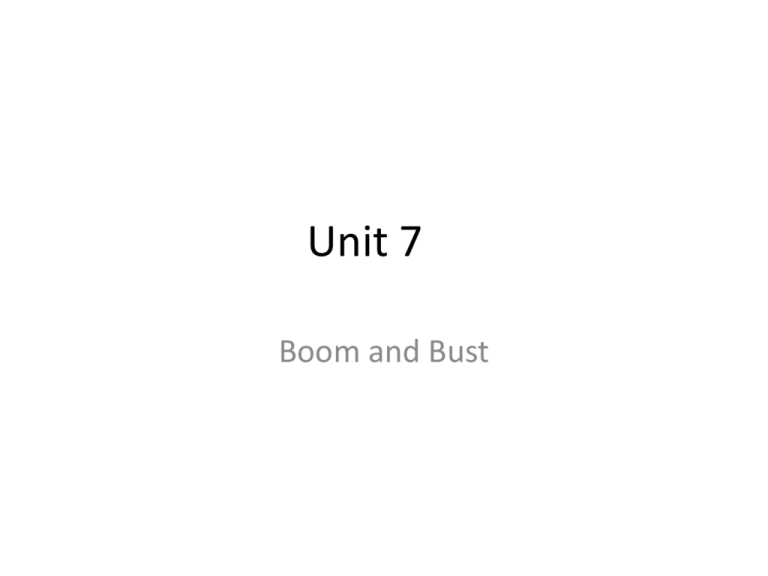
Unit 7 Boom and Bust A Resurgence of Nativism • Because of the red scare- the fear that communist would threaten freedom in the United states • Palmer raids- A. Mitchell palmer- started arresting suspected communist Nativism • Eugenics is a false(pseudo) science that deals with the improvement of hereditary traits. – Nativists thinking that white Protestants from northern Europe who first came to America were the superior stock. • One of the biggest movements to restrict immigration in the 1920’s came from the Ku Klux Klan. – After World War I, the Klan targeted immigrants, Catholics, Jews and other groups they believed did not represent traditional American values Ku Klux Klan restarted at Stone Mt Ga. by William Simmons 1915 Immigration • To control immigration congress passed the Emergency Quota Act and national origins act – The law set up a quota system. – Discriminated against southern and eastern Europe immigrants. • These two laws caused a shortage in labor – These Acts did not include natives of the Western Hemisphere. More than 600,000 Mexicans arrived in the United States between 1914 and the end of the 1920s. New Morality • New Morality stressed youth and personal freedom – In the family, the new morality focused on the ideas of romance, pleasure, and friendship for a successful marriage. – Automobile played important part in new morality. • Flappers- New fashion that started in 20’s – Women shortened their hair and wore silk stockings. – A flapper was a young, dramatic, stylish, and unconventional woman. She smoked cigarettes and drank liquor. She also dressed in clothes considered too revealing by many. • Fundamentalism Movement – stressed the teachings of the bible. – Fundamentalist rejected the theory of evolution and supported the creation theory. Flappers • Scopes Monkey Trial- where Evolutionist and Creationist collided – John T. Scopes taught evolution in a Dayton, Tennessee classroom. It was against the law to teach evolution in Tenn. – Clarence Darrow was Scopes lawyer, and Williams Jennings Bryan was the prosecutor. – Scopes was found Guilty for teaching evolution in the classroom and had to pay $100 fine. – Conviction was later overturned Clearance Darrow(left)/ William Jennings Bryan (right) Unit 7 • • • • Boom and Bust Economy Roaring 20’s Great Depression New Deal Unit 7 Prohibition • People started supporting Prohibition in early 1900’s – People believed Prohibition would • Reduce domestic violence • Reduce unemployment • Poverty • 18th amendment took effect January 1920 – provided for prohibition –no sale or consumption of alcohol • Speakeasies- bars where you could buy alcohol – Organized crime ran these bars. – Alcohol imported from places like Canada and Caribbean. – 21st amendment passed in 1933. Overturned the 18th. Organized Crime Cultural Innervations • Many Americans in the 1920s had more money and more leisure time than they ever had before. – People watched Boxing and Baseball with leisure time • Motion picture became popular. They had no sound yet, music was provided during the showing. • Radio and music also became popular • Mass media was radio, movies, newspapers, and magazines aimed at a broad, popular audience-helped to expand people’s view of the world. It helped unify the nation and spread the new ideas of the time. African American Culture • Many African Americans was part of the Great Migration. This was where blacks left the south to go to the industrial north. – Night clubs and music started to flourish in northern cities like New York. – Harlem was center the center for artistic development, racial pride, and a feeling of community. This was called the Harlem Renaissance – Langston Hughes (writer) , Louis Armstrong introduced an improvisational form of jazz, and Duke Ellington. Harlem Renaissance Continued • Like other African American musicians, Duke Ellington got his start at the Cotton Club. This was one of the most famous Harlem nightspots. • Blues- a soulful style of music that evolved from African American spirituals. • Tin Pan alley- group of music houses in New York City where artists preformed their songs – Irving Berlin- most famous artists in tin pan alley – White Christmas, God Bless America, there’s no business like show business, Louis Armstrong African American Politics • Population of African Americans increased in the North. – Voting blocs were established. African Americans in Chicago elected Oscar DePriest, the first African American representative in Congress from a Northern state. • NAACP- lobbied against segregation, lynching, and discrimination • Marcus Garvey formed the Universal Negro Improvement Association (UNIA) – Advocating separation of the races. – He urged African Americans to move to Liberia, Africa Chapter 21 Presidential Politics • Warren G. Harding elected president in 1920 –He ran on the campaign slogan to return to normalcy, or a return to “normal” life after the war. The New Rise of Industry • Automobiles became an important part to American life. –Mass production –Henry Ford perfected it –Assembly Line (Henry Ford)- saved time and money • Model T Video on the Automobile • Airline industry – Charles Lindbergh made a solo flight across the Atlantic Ocean in the Spirit of St. Louis • Commercial radio also became popular in the 1920s. • National Broadcasting Company, Columbia Broadcasting System Charles Lindbergh Consumer Society • Higher Wages led to increase buying power. • Americans started buying items on credit. (cars and furniture) Farm Crisis • Farmers did not prosper in the 1920. • New technology increased production • During WW1 farmers produced more food to feed Europe • Europe because of tariffs stopped buying agriculture products from America. • 1920’s Boll Weevil Stuck the south and destroyed the cotton crop Promoting Prosperity • Harding and Coolidge both opposed govt. regulation of businesses – Secretary Andrew Mellon came up with supply-side economics - He believed that as the economy grew, Americans would earn more money and the government would actually collect more taxes at the lower rate than it would if the tax rates were kept high. – Herbert Hoover came up with cooperative individualism- idea encouraged manufacturers and distributors to form trade associations, which would voluntarily share information with the government Trade and Arm Control – Most Americans after World War I favored Isolationism. – European allies had a hard time paying America back for war debt • The United States and 14 other nations signed the Kellogg-Briand Pact-stated that all signing nations agreed to abandon war and negotiate disputes peacefully. Chapter 22 • Caused of the depression • Election of 1928 – Herbert Hoover (Rep) • Supported prohibition • Quaker • Hoover wins in a landslide – Alfred E. Smith (Dem) • Roman Catholic (1st to be nominated for president) • Opposed the idea of prohibition Herbert Hoover / Alfred Smith Roots of the Great Depression • Causes of Great depression – – – – 1.Underconsumption 2.Speculation 3.Over production of manufactured goods 4. Installment plans- paid for items in monthly installments • People had to stop buying items to pay for items already bought. Sales slowed and production was cut. Because of this people were laid off. – Americans were not selling many goods to foreign countries • Hawley-SmootTariff- raised taxes on imports. Other countries raised their tariffs on American products. American products stopped being bought overseas because of this. – Federal Reserve- they lowered interest rates which allowed for banks to give risky loans. Lower interest rates led business leaders to believe the economy was still growing. They borrowed more money to expand they industry. • Stock market – It experienced a bull market during the late 1920’s – Speculation- investors were betting that the stock market would continue to climb and then sell the stock quickly to make money. – Oct. 29, 1929 Black Tuesday- stock market crashed • Banks – Lent money to stock speculators – invested depositors’ money in the stock market – Stock market crash caused banks to lose money, and not get paid back by speculators Life during the Great Depression • Banks failed, thousands of companies went out of business, people lost homes and was unable to provide food. • People who lost homes built shantytownshomeless that built shacks on unused public lands. Also known as Hoovervilles • Hobos • Midwest farmers stopped planting croups because prices fell. Plains experienced a server drought 1932. Plains became a dust bowl. Hoovervilles Dust bowl Where did the dustbowl happen at? Dust Bowl happened in Great Plains Why were people leaving the area shown in the map? Dust bowl Escaping the Great Depression • People went to the movies and watched Cartoons. Walt Disney produced the 1st full length cartoon. • Americans listened to radio (lone Ranger) • Writers John Steinbeck “The Grapes of Wrath”-about people who left the dust bowl,and William Faulkner- wrote in a new style called stream of consciousness- it is where the characters thoughts are expressed. Hoover Responds • Hoover got a pledge from businesses owners to keep factories open and stop cutting wages. • Public works• Hoover believed deficit spending would delay the recovery. The angry American • Hoover did not want to give direct relief to poor families. • 1932 crowds of people marched on Washington. • Creditors foreclosed on a million farms between 1930-34 • Bonus Army- veterans of World War 1 who wanted their bonus early. – Bonus Army lived in Hoovervilles and solders were sent in to clear out the bonus army. Bonus Army • 1932 presidential election – Rep. Herbert Hoover – Dem. Franklin D. Roosevelt • New Deal- Roosevelt's programs for ending the Great depression. • FDR – He was Wealthy, educated at Harvard, Columbia law school, contracted polio, secretary of war, Governor of (NY) . Roosevelt depended on his wife Eleanor to keep his name in the forefront in the New York Democratic Party (when had polio). Elected Pres. 1932. • People were scared Roosevelt would get rid of the Gold standard. • Because of this people went to banks to get money out of banks and exchange it for gold. • In 38 states, governors declared bank holidays. • By 1933 4000 banks collapsed. The First New Deal • 1st Hundred days- congress passed 15 major laws to deal with the economy (1st new Deal) • • Roosevelt had advisors that disagreed with each other. A bank holiday and special secession of congress was called. – Emergency Banking Relief Act-federal officials would check the nation’s banks and give licenses to those that were financially sound. • Fireside chats- let people know what FDR was trying to accomplish. – 1st chat he told public it was safe to put money back in banks. • FDIC-Federal Deposit Insurance Company- provided govt. insurance for bank deposits up to a certain amount. • Securities and Exchanges Commission (SEC)- regulate stock market and prevent fraud The New Deal Migrant Mother Photo • This picture showed the despair people had during the great depression • She sold her tires to buy food for her seven kids Managing Farm and Industry • Agricultural Adjustment Administration(AAA)Govt. would pay farmers not grow certain crops and livestock – Millions of acres took out of production – Farmers received 1 billion in payments – Surplus decreased and prices increased. – Large commercial farmers benefited • National Industrial Recovery Act (NIRA) – Suspended anti-trust laws – Voluntary rules for each business – Set prices and minimum wage – National Recovery Administration- ran the NIRA – Businesses who sign agreement to abide by the codes received signs displaying NRA symbol – People encouraged only to by from these businesses Providing debt relief • Home Owners’ Loan Corporation (HOLC) – Bought mortgages from home owners behind on payments – Reconstructed loans with lower interest rates • Farm Credit Administration (FCA)– Gave famers loans where they could keep their land Spending and Relief Programs • Some advisors believed Roosevelt needed to find a way to provide money to people. – Civilian Conservation Corps (CCC 1933) • Employed 18-25 year old men • Planted trees, fought fires, and built reservoirs • Provided work for about 3 million men Tennessee Valley Authority • • • • Control floods 20 dams were built Employed 40,000 workers at one time Provided cheap electricity to rural areas Roosevelt and New Deal Political cartoons Challenges to the New Deal –Huey Long (left)- believed the government was not going far enough. Wanted govt. to shift wealth from the rich to the middle class and poor. –Redistribution of wealth Second New Deal • Works Progress Administration (WPA) – 8.5 million workers – Built highways, roads, public buildings parks – murals • Wagner Act– Guaranteed workers right to form unions and collective bargaining – Binding arbitration – Made Unions increase • CIO (Committee for industrial workers) Later became Congress of Industrial Organizations. Social Security Act • Disability • Retirement • Unemployment The New Deal Coalition • Roosevelt included African Americans and Women to positions in his administration. – Francis Perkins- 1st women to a cabinet position Secretary of Labor • Supreme Court struck down many New Deal Programs – Roosevelt’s solution was court-packing. • Interfering with separation of powers • Southerners worried FDR would appoint justices that would overturn segregation in the south. • Hurt FDR reputation • Roosevelt cut spending and the economy declined • Two theories emerged to help the economy: – Secretary of Treasury Henry Morgenthau wanted to balance the budget and cut spending – John Keynes (Keynesianism)- during a recession govt. should spend a lot even go into debt. • Legacy of the New deal – The government became a broker state- a mediator between two groups – Safety net- safeguards and reliefs that programs that protected average Americans from an economic disaster. – People now believed the govt. had a duty to keep the safety net – The new deal programs did not bring the United States out of the depression. WWII did
